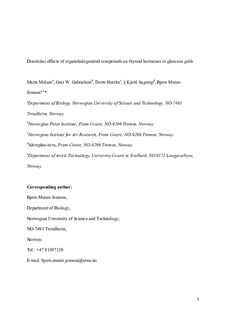| dc.contributor.author | Melnes, Marte | |
| dc.contributor.author | Gabrielsen, Geir W | |
| dc.contributor.author | Herzke, Dorte | |
| dc.contributor.author | Sagerup, Kjetil | |
| dc.contributor.author | Jenssen, Bjørn Munro | |
| dc.date.accessioned | 2017-09-29T12:20:24Z | |
| dc.date.available | 2017-09-29T12:20:24Z | |
| dc.date.created | 2017-09-14T10:37:25Z | |
| dc.date.issued | 2017 | |
| dc.identifier.citation | Environmental Research. 2017, 158 350-357. | nb_NO |
| dc.identifier.issn | 0013-9351 | |
| dc.identifier.uri | http://hdl.handle.net/11250/2457519 | |
| dc.description.abstract | The glaucous gull (Larus hyperboreus) is an arctic top predator and scavenger exposed to high levels of mixtures of organohalogenated contaminants (OHCs) of which many interfere with the thyroid hormone (TH) system. In the present study, we applied statistical modeling to investigate the potential combined influence of the mixture of chlorinated, brominated and perfluorinated organic compounds in plasma of glaucous gulls on their plasma TH concentrations. In females, there were significant negative associations between several organochlorinated compounds (OCs) and free thyroxin (FT4) and triiodothyronine (FT3), indicating additive negative effects on FT4 and FT3. However, in these females there was also a significant positive association between perfluorooctane sulfonate (PFOS) and FT3. The inverse associations between several OCs and FT3 and the contrasting positive association between PFOS and FT3, indicate that these two groups of OHCs may have dissimilar and antagonistic effects on FT3 in female glaucous gulls. In males, there were no associations between any of the OHCs and the THs. That OHCs affect THs in a complex manner involving both additive and antagonistic effects add to the challenge of interpreting the overall functional effect of thyroid disruptive chemicals in wildlife. However, experimental studies are needed to confirm or disprove such effects. | nb_NO |
| dc.language.iso | eng | nb_NO |
| dc.publisher | Elsevier | nb_NO |
| dc.rights | Attribution-NonCommercial-NoDerivatives 4.0 Internasjonal | * |
| dc.rights.uri | http://creativecommons.org/licenses/by-nc-nd/4.0/deed.no | * |
| dc.title | Dissimilar effects of organohalogenated compounds on thyroid hormones in glaucous gulls | nb_NO |
| dc.type | Journal article | nb_NO |
| dc.type | Peer reviewed | nb_NO |
| dc.description.version | acceptedVersion | nb_NO |
| dc.source.pagenumber | 350-357 | nb_NO |
| dc.source.volume | 158 | nb_NO |
| dc.source.journal | Environmental Research | nb_NO |
| dc.identifier.doi | 10.1016/j.envres.2017.06.007 | |
| dc.identifier.cristin | 1493658 | |
| dc.description.localcode | This is the authors' accepted and refereed manuscript to the article. Locked until 03 July 2019 due to copyright restrictions | nb_NO |
| cristin.unitcode | 194,66,10,0 | |
| cristin.unitname | Institutt for biologi | |
| cristin.ispublished | true | |
| cristin.fulltext | postprint | |
| cristin.qualitycode | 2 | |

